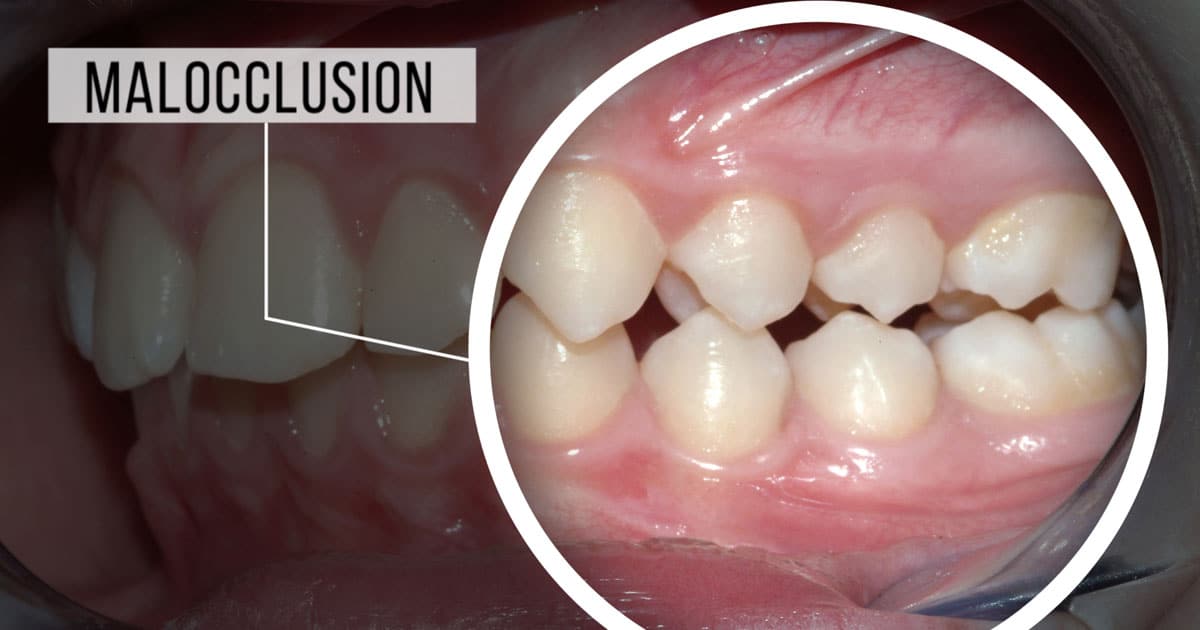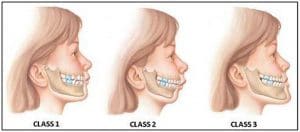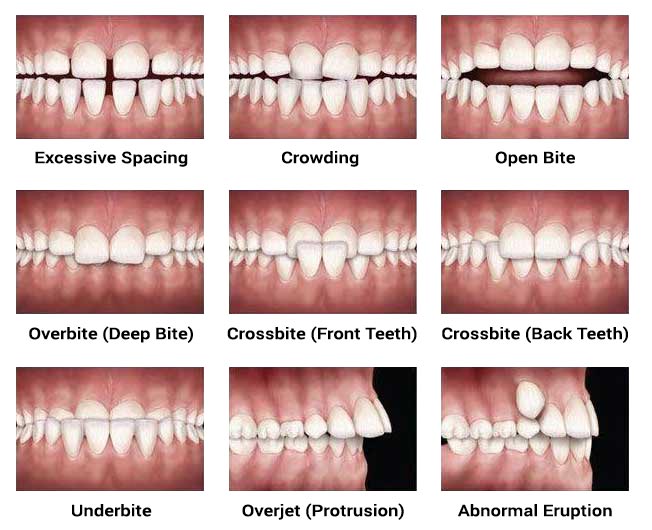Malocclusion : Causes, Symptoms, Classification and Treatment

Malocclusion is the term used to describe an overbite, underbite, or any issues caused by misaligned and crowded teeth. Rotation or twisting of the teeth can also be associated with malocclusion.
Your teeth cannot function properly if they’re in this condition, which may lead to oral and digestive health problems. In severe cases, malocclusion is also linked to reoccurring headaches and depression.
“Occlusion” refers to the alignment of the teeth. When your teeth are in a correct position, there are no issues with crowding or spacing. As a general rule, your upper teeth should overlap your bottom teeth a little, and your molars should be in a corresponding position to their counterpart molars.
There are different levels of malocclusion, though any kind of misalignment can be problematic. Here we present an overview of this common dental concern.
Causes of Malocclusion
Malocclusion runs in families and most are born with it. There are also some conditions and habits that can alter the structure of your jaw. These include:
- Cleft lip and palate
- Tumors
- Airway obstruction
- Injuries
- Abnormally shaped or impacted teeth
- Pacifier overuse
- Thumb sucking
- Overuse of bottle feeding
- Poor dental care that affects dental appliances
Symptoms of Malocclusion
The following symptoms may arise at depending on the level of severity:
- Improper alignment of the teeth
- Changes in facial appearance
- Discomfort when using the teeth
- Mouth breathing
- Speech troubles
- Biting of the cheeks or tongue
Classification
Dentists diagnose malocclusion during an exam through inspection and X-ray imaging. Malocclusion is categorized into three levels, depending on the severity of symptoms.
- Class 1 malocclusion is diagnosed when there is an overlap of the upper teeth. This is the most common form of misalignment.
- Class 2 malocclusion is where there is a more severe overbite. This condition is also known as retrognathia.
- Class 3 malocclusion is diagnosed in cases of severe underbite. This is called prognathism. In this condition, the lower jaw protrudes forward.
Treatments for Malocclusion
In cases of moderate malocclusion, treatment may not be necessary. A more severe case may require the attention of an orthodontist. Treatment may include:
- Braces
- Tooth extraction
- Modification of the teeth
- Jaw surgery
- Wires or plates to stabilize the jaw
Treatment may bring about the following complications:
- Tooth decay
- Pain
- Irritation caused by dental appliances
- Difficulty chewing or speaking
How To Prevent Malocclusion
Since the problem is often hereditary, there is little that can be done in terms of prevention. However, parents should consult their dentist about limiting the use of pacifiers and baby bottles in order to prevent further malocclusion.
Additionally, early diagnosis and treatment can reduce the need for more serious intervention later in life.
Malocclusion and Speech Problems
If you have a lisp or whistle when you try to pronounce certain words, then you know that this can be a problem in your professional and social life, leading to lowered self-esteem. Few people know that the positioning of their teeth may be responsible for their speech problems.
Crossbite
When your jaw structure is properly aligned, the upper teeth are slightly more forward than the lower ones. There are conditions where the overlap is severe (overbite), or the lower jaw extends beyond the upper jaw.
Crossbite is a condition where the position of one or more teeth is reversed. A crossbite may cause you to produce certain speech sounds improperly. When you attempt to produce the sounds S, Z, or L, you end up producing T, N, or D instead.
Open Bite
An open bite occurs when your front teeth are projected outwards so much that the teeth of the upper and lower jaw don’t meet. Similar to a crossbite, the open bite may result in an inability to properly pronounce your S.
Overjet
Usually, there’s a small space between the upper and lower incisors. If the space is too big, the condition is called overjet. This is also known as buck teeth. This condition ends up with a problem pronouncing sibilant sounds. These are sounds with a hissing effect.
Malocclusion and Headaches
Most dental headaches are classified as tension headaches. They’re spurred on from tension that builds up in your face and jaw. Many times the tension is a symptom of malocclusion.
When you have a bad bite, your chewing surfaces don’t meet along a smooth curve when the jaw is closed. This results in overcompensation by the muscles in the jaw. This can lead to pain that radiates throughout the head.
Sometimes, the problem may be difficult for a medical professional to diagnose. The fact that the pain radiates means that its origin will be hard to detect. Your dentist may recognize this, leading them to look for the source of the problem in malocclusion.
Malocclusion and Quality of Life
Research shows that malocclusion can have an impact on quality of life and daily performance. One study observed young Japanese adults to see if there would be any impact on their daily performance. It was found that subjects with impacts on daily performance had a significantly higher rate of malocclusion than the others. Additionally, it was found that the negative impacts on daily performance contribute to psychological stress.
Malocclusion can be a serious problem. Thankfully, dentists and orthodontists are expertly trained to determine the best course of action. If you are a parent, it’s important to resolve malocclusion issues that your children may have early on in order to prevent it from manifesting and affecting you child negatively throughout their lives.


